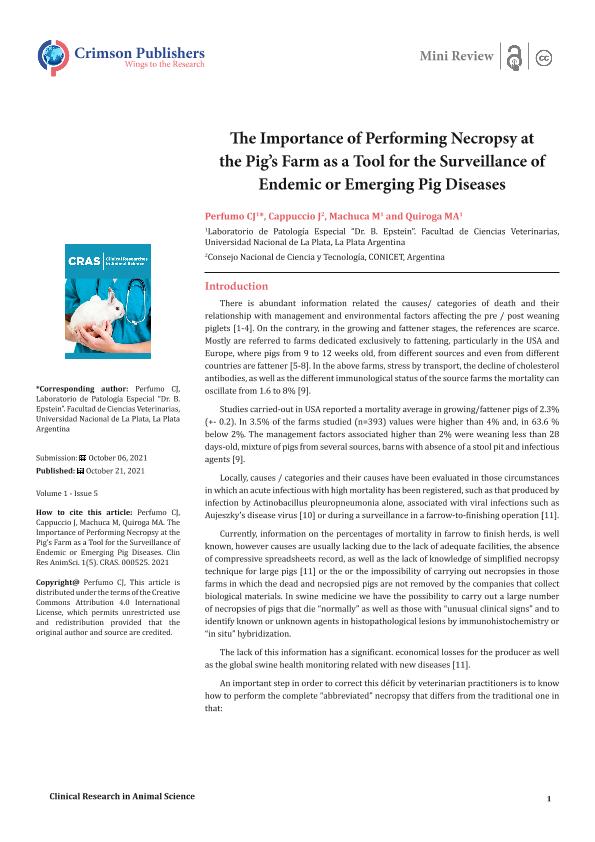Artículo
The Importance of Performing Necropsy at the Pig’s Farm as a Tool for the Surveillance of Endemic or Emerging Pig Diseases
Perfumo, Carlos Juan; Cappuccio, Javier Alejandro ; Machuca, Mariana Alejandra; Quiroga, María Alejandra
; Machuca, Mariana Alejandra; Quiroga, María Alejandra
 ; Machuca, Mariana Alejandra; Quiroga, María Alejandra
; Machuca, Mariana Alejandra; Quiroga, María Alejandra
Fecha de publicación:
10/2021
Editorial:
Crimson Publishers
Revista:
Clinical Research in Animal Science
ISSN:
2770-6729
Idioma:
Inglés
Tipo de recurso:
Artículo publicado
Clasificación temática:
Resumen
There is abundant information related the causes/ categories of death and their relationship with management and environmental factors affecting the pre / post weaning piglets. On the contrary, in the growing and fattener stages, the references are scarce. Mostly are referred to farms dedicated exclusively to fattening, particularly in the USA and Europe, where pigs from 9 to 12 weeks old, from different sources and even from different countries are fattener. Locally, causes / categories and their causes have been evaluated in those circumstances in which an acute infectious with high mortality has been registered.Currently, information on the percentages of mortality in farrow to finish herds, is well known, however causes are usually lacking due to the lack of adequate facilities, the absence of compressive spreadsheets record, as well as the lack of knowledge of simplified necropsy technique for large pigs or the or the impossibility of carrying out necropsies. In swine medicine we have the possibility to carry out a large number of necropsies of pigs that die “normally” as well as those with “unusual clinical signs”.
Palabras clave:
SWINE
,
NECROPSY
,
DISEASE
,
SURVEILLANCE
Archivos asociados
Licencia
Identificadores
Colecciones
Articulos(CCT - CORDOBA)
Articulos de CTRO.CIENTIFICO TECNOL.CONICET - CORDOBA
Articulos de CTRO.CIENTIFICO TECNOL.CONICET - CORDOBA
Citación
Perfumo, Carlos Juan; Cappuccio, Javier Alejandro; Machuca, Mariana Alejandra; Quiroga, María Alejandra; The Importance of Performing Necropsy at the Pig’s Farm as a Tool for the Surveillance of Endemic or Emerging Pig Diseases; Crimson Publishers; Clinical Research in Animal Science; 1; 5; 10-2021; 1-3
Compartir



